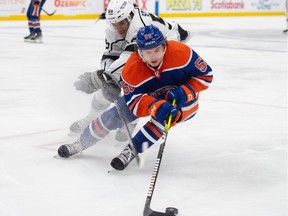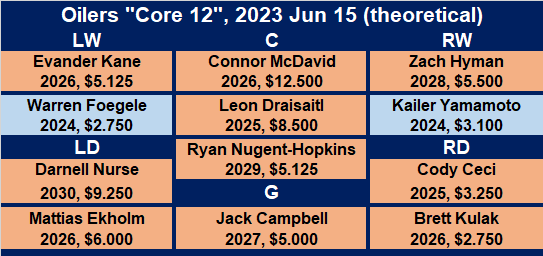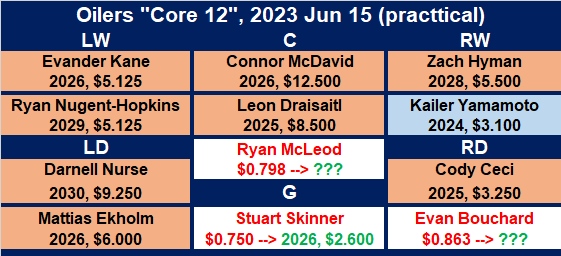Ken Holland’s job is not getting any easier.
Ken Holland’s job is not getting any easier.
Moreover, none of the players who they have effectively passed on the depth chart is going anywhere. Not without direct intervention in the form of a trade or in the worst-case scenario, a buyout. With the window for buyouts opening today, we’ll dig a little deeper on 3 possible options.
First though, let’s have a look at Edmonton’s Core 12, defined as the #1 goalie, top 2 defence pairs, top 2 forward lines, #3 centre. 2 variations follow, the first as it currently exists in theory, and then in reality.
The former is not too different from the one presented here 11 months ago, with just 2 changes: Jesse Puljujarvi out, Warren Foegele “promoted” from depth to core player; and Tyson Barrie out, Mattias Ekholm in. The other 10 players remain in place, all on pre-existing contracts. They are in fact, the top 12 cap hits on the club, and the 10 longest remaining terms.
With Puljujarvi (2023) and Barrie (2024) both moved out, there remain just 2 of the lesser pacts that are due to expire in a year’s time (blue background). The rest are locked up until 2025 and beyond (orange background).
Add it up and it’s a cool $68.85 million for those 12 players, more than $5.7 million per. Add in a couple of fixed costs — James Neal’s buyout ($1.917) and Bouchard’s bonuses from last season ($0.850) — and we’re up in the range of $71.6 million, about $12 million below the projected cap ceiling of $83.5 million in 2023-24.
Note that this model employs Connor McDavid, Leon Draisaitl and Ryan Nugent-Hopkins at the centre position, whereas in reality all 3 typically play in the top 6, with either Draisaitl or RNH on the wing.
It also does not account for the major steps forward made by a couple of younger players on now-expired pacts. As I see it, here’s a more realistic layout of Edmonton’s current Core 12:
This is closer to the line-up Oilers fans saw in the playoffs, with Stuart Skinner locked in at #1G, Evan Bouchard at 2RD, Ryan McLeod at 3C. So far only Skinner has been re-signed, with a substantial raise of $1.85 million. Bouchard and McLeod are both restricted free agents both due solid raises of their own. I keep hearing figures like $4 million to sign Bouchard to a bridge deal and $2 million to do likewise with McLeod.
Which might be fine if those guys were moving in to “open” positions. The problem with this model is that all of Jack Campbell, Brett Kulak and Foegele remain on the roster, outside the Core 12 even as they are set to collectively draw $10.5 million against the cap. Ouch.
Add in the existing contracts and the projected raises to expired ones and the math simply doesn’t add up, at least not to a cap-compliant figure. And there lies the root of Holland’s headaches in the summer of 2023.
A case in point can be found in the 2 contract extensions that have already been signed: a $1.85 million raise for Skinner, and marginal savings of $350,000 on the recent Derek Ryan extension. That’s 2 returning players outside the “theoretical” Core 12, but with a net increase of $1.5 million against the cap. It would take 4 more Ryans just to pay for Skinner’s raise, let alone those of Bouchard and McLeod.
The Oilers have exactly 1 more Derek Ryan, namely Mattias Janmark who similarly made $1.25 million last year. He too could take a haircut or be replaced with a cheaper player. Make it happen and now you’ve paid 50% of Skinner’s raise and nothing against the others.
ALL of the other expired contracts are below $1 million, moreover one of them is a cut rate $450,000 which cannot be replicated. Best case scenario is that the Oilers re-sign or replace this group at about the same net cost as before. So where do the raises for Bouchard, McLeod and for that matter Klim Kostin come from?
Only way to do it is to offload a more expensive player or two, bearing in mind that all of these guys are under contract, and those over $5 million have no move clauses. Did I mention Holland’s job isn’t getting any easier?
Here are his options:
Jack Campbell
Some would suggest targeting the contract at exactly $5 million. Signed to a 5-year pact at that annual value, it took Campbell about 5 weeks to lose his claim to the #1 job he was hired for. Such a move would result in an immediate return of $3.46 million against the 2023-24 cap, minus of course the cost of a replacement goalie.
I just don’t see it happening. “Soup” was a high profile signing in the first minute of free agency not 12 months ago. It would be highly embarrassing to admit defeat at this point and more importantly, premature. Not only would a buyout leave a ~$1.5 million drag on the club’s salary cap through (shudder) 2031, such a panic move would surely be a colossal red flag for future free agents thinking of moving to Edmonton.
As I see it, barring some sort of giant trade that involved goalies both coming and going, Holland has little choice but to give the netminder a fresh start in the fall and see how he responds to the challenge. Campbell isn’t the first goaltender to struggle in his first year behind a new team, and he wouldn’t be the first to bounce back hard the following season either. But until he does, his remaining contract is a serious net negative that would be costly to get out from under. Pretty good chance that pact has reached its lowest value right now, which would make it a poor time for the Oilers to be moving on.
___
2 contracts do stand out as being moveable: the 2 forwards in the $3 million range who each have a year to run. Those are the 2 names with blue backgrounds in our first graphic.
It may well be that Holland will have to offload both Kailer Yamamoto and Warren Foegele to solve the salary bumps he will be issuing to the rising young players already mentioned. We will review the 2022-23 performance of each in our next post; here we will consider only the ways Edmonton might offload their contract/s a year early.
Kailer Yamamoto
If it were to come down to a buyout, due to his young age (24) Yam is only entitled to 1/3 of his remaining salary (technically $3.2 million in 2023-24). That would result in a cap hit of just $433,000 this upcoming season, $533,000 the year after. Meaning a cap “savings” in excess of $2.6 million, minus the cost of a replacement player. Which would still leave some savings, but not enough to cover all of those RFA raises, both real (Skinner) and projected (Bouchard, McLeod Kostin).
I do believe this player would have some value on the trade market. Viewed through a longer lens, he’s a 24-year old winger with 50 big league goals who is one year removed from a 20-goal, 40-point season. The key is not to take salary back, nor to retain any. But it would be nice to cash a draft pick in a year the Oilers only have 3 less than a fortnight before the Draft. How high? Beggars can’t be choosers.
Warren Foegele
As for Foegele, at 27 he is entitled to 2/3 of his remaining salary if bought out. If the Oilers felt compelled to do so, such a move would “save” $2.17 million toward the cap this season, minus the cost of his replacement. But the club would absorb a hit of $1.08 million in the second year. That would be painful, though that is the year that the cap ceiling is expected to take its first major bump in 5 long years. Putting off the hit until then would be a bit of a win, with the caveat that no matter how much the cap rises in 2024-25, you can only spend it once.
Hard to believe the Oilers wouldn’t be able to move this player via the trade route. The price tag is a bit dear, but to a team that has the cap space he’d be a real good add. In a similar vein, Edmonton would miss him. Just another “price you have to pay”, I guess.
Conclusion
The (first) buyout window extends from Jun 16-30, so the obvious play here is for Holland to work the trade market. The NHL Draft on Jun 28-29 crowds the back end of that window, and is also the busiest time for trades, so don’t expect any buyouts to be announced until the last day.
I don’t expect any to be announced at all, and am looking instead to a busy trading window before and at the Draft.






